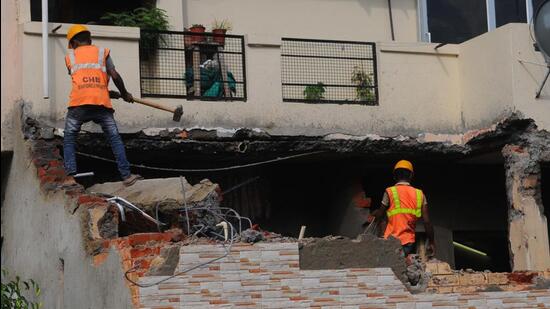Regularisation of building violations: CHB committee says no to Delhi pattern
CHB committee says 100% regularisation of all violations within boundary and within skyline, as done in Delhi, cannot be permitted here
In a major setback to the hundreds of Chandigarh Housing Board (CHB) allottees, the CHB committee, set up to examine requests for need-based changes in its residential units, has turned down regularisation based on Delhi pattern.

In its report, which will be taken up for a decision by the CHB Board of Directors at a meeting on July 26, the committee has stated that 100% regularisation of all violations within boundary and within skyline, as done in Delhi, cannot be permitted.
The committee, headed by the CHB secretary, contends, “100% regularisation is not possible as various conditions such as light and ventilation, zoning of the area, street picture and structural stability of existing structure/violations are to be considered.”
The committee, constituted in September last year, comprises technical experts and three non-official board members. CHB board, headed by the UT adviser, will take the final call on its recommendations.
For a long time CHB allottees have been demanding regularisation of building violations based on the Delhi pattern, which includes one-time settlement for all existing violations by allowing additional FAR (floor area ratio) on payment of certain charges.
It also covers regularisation of major violations like additional floors, extension of kitchen, extended/extra balconies and other alterations, projection of cantilevers on the government land and construction of balcony /stairs/bathrooms on such projected cantilevers.
In Chandigarh, however, CHB has been regularly demolishing building violations and penalising the violators.
Violations galore
According to CHB estimates, 90% of its 65,000-odd dwelling units in the city have massive structural violations in one way or another.
Over 4.5 lakh people are estimated to be living in CHB dwelling units. In case violations are not removed at own cost, allotment may be cancelled and possession resumed.
In 2019, the board had issued a policy, allowing residents to regularise many unauthorised constructions in their flats. But only 40 applications were received, as the policy is applicable only for additions or alterations within CHB dwelling units and not outside encroachments.
The CHB allottees complain that the need-based changes allowed in the policy didn’t resolve their concerns.
Why the committee said no
Chandigarh, a planned city, is not comparable to Delhi
It is located in seismic zone 4 and unauthorised construction can pose danger to life and property
Illegal constructions can block light and ventilation
Cantilever projections on government land are encroachments
Regularisation gives undue incentives for further violations
Any excess FAR and changes beyond permitted norms of master plan may require approval of the Union ministry of home affairs
The three non-official CHB board members, who are also on the committee, have instead recommended phase-wise regularisation, starting with violations within the unit’s boundary wall
Later, CHB may consider regularisation of constructions on public land at reasonable cost
They also recommended that additional rooms up to 150 square feet may be regularised, but allottee should not be given any legal right over it.
Demands accepted by committee
No prior written consent needed from all adjacent allottees for making internal changes in a house, additional door, façade painting and construction of elevators
For categories other than EWS/LIG, additional coverage increased from 50% to 75% subject to maximum of 150 square feet
The front courtyard brick boundary wall can be replaced with flexible/sliding gates
Solar panels may be installed on terrace subject to the consent of all allottees of the block
The allottees are allowed to increase the total capacity of water tank up to a maximum of 1,000 litres
Removal of wall thicker than 115 mm allowed in independent houses.





